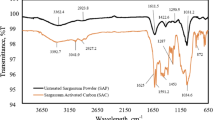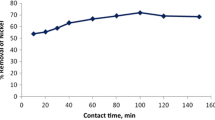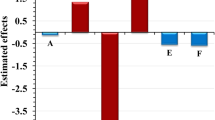Abstract
This study was undertaken to investigate the biosorption of lead (Pb) by marine microalgae D. salina through batch model. The D. salina was isolated and identified by standard method and mass cultured in outdoor condition with optimum condition. The sorbent was prepared and analysed through FT-IR spectroscopy, and observed active functional groups such as alkyl halide (C-I and C–Cl), alcohol (C-O), aromatic (C = C), alkene (C = C), C≡N, alkyl (C-H) and amine (N–H) with different stretching were observed at the wavelength between 501.71 and 2897.19 cm−1. The batch experiment was conducted with several factors such as pH, contact time and sorbent dosage. In the pH experiment, the results were shown pH dependent, and the maximum Pb absorption was noticed for 4.5 mg/L at the pH of 7–8, and the lowest Pb absorption was recorded 1.1 mg/L at the pH of 12. In time duration set, the absorption was noticed time dependent, and maximum of Pb removal by contact time was noticed higher in 120 min of 3.9 mg/L and lower absorption in initial time of 30 min. The influence of sorbent dosage on Pb removal was displayed concentration dependent, the maximum removal of lead 6.1 mg/L was noticed in 10 g L−1, and the lowest removal was observed in initial dosage of 2 g L−1. In conclusion, D. salina has more metal binding functional groups and sites on surface, and also it is a cheap cost additional biosorbent for removal of metal from industrial effluents.




Similar content being viewed by others
References
Senthil Kumar P, Senthamarai C, Sai Deepthi ASL, Bharani R (2013) Adsorption isotherms, kinetics and mechanism of Pb(II) ions removal from aqueous solution using chemically modified agricultural waste. Can J Chem Engg 91:1950–1956
Christopher FC, Anbalagan S, Senthil Kumar P, Pannerselvam SR, Vaidyanathan VK (2017) Surface adsorption of poisonous Pb(II) ions from water using chitosan functionalised magnetic nanoparticles. IET Nanobiotechnol 11(4):433–442
Suganya S, Saravanan A, Senthil Kumar P, Yashwanthraj M, Sundar Rajan P, Kayalvizhi K (2017) Sequestration of Pb(II) and Ni(II) ions from aqueous solution using microalga Rhizoclonium hookeri: adsorption thermodynamics, kinetics, and equilibrium studies. J Wat Reuse Desal 7(2):214
Estrella LR, Garcia G, AA (2009) Heavy metal adaptation. In Encyclopedia of Life Sciences (ELS) John Wiley & Sons, Ltd Chichester, UK 1–9pp
Suganya S, Kayalvizhi K, Senthil Kumar P, Saravanan A, Vinoth Kumar V (2016) Biosorption of Pb(II), Ni(II) and Cr(VI) ions from aqueous solution using Rhizoclonium tortuosum: extended application to nickel plating industrial wastewater. Desal Water Treat 57:25114–25139
Saravanan A, Senthil Kumar P, Yaashika PR, Karishma S, Jeevanantham S, Swetha S (2021) Mixed biosorbent of agro waste and bacterial biomass for the separation of Pb(II) ions from water system. Chemosphere 277:130236
Ahmed I, Iqbal HMN, Dhama K (2017) Enzyme-based biodegradation of hazardous pollutants—an overview. J Exp Biol Agri Sci 5:402–411
Ullah S, Zuberi A, Alagawany M, Farag MR, Dadar M, Karthik K, Tiwari R, Dhama K, Iqbal HMN (2018) Cypermethrin induced toxicities in fish and adverse health outcomes: its prevention and control measure adaptation. J Environ Manag 206:863–871
Rasheed T, Bilal M, Nabeel F, Iqbal HMN, Li C, Zhou Y (2018) Fluorescent sensor based models for the detection of environmentally-related toxic heavy metals. Sci Total Environ 615:476–485
Ghaly AE, Ananthashankar R, Alhattab MVVR, Ramakrishnan VV (2014) Production, characterization and treatment of textile effluents: a critical review. J Chem Eng Process Technol 5:1–19
Priyadarshanee M, Das S (2021) Biosorption and removal of toxic heavy metals by metal tolerating bacteria for bioremediation of metal contamination: a comprehensive review. J Environ Chem Engg 9:104686
Senthil Kumar P, Gayathri R, SenthilRathi B (2021) A review on adsorptive separation of toxic metals from aquatic system using biochar produced from agro-waste. Chemosphere 285:131438
Dineshkumar R, Kumaravel R, Sampathkumar P (2016) Cultivation of efficient marine microalgae and their biochemical composition and its antibacterial activity against human pathogens. J Aqua Mar Biol 5(4):001–027
Lananan F, Jusoh A, Ali N, Lam SS, Endut A (2013) Effect of Conway medium and f/2 medium on the growth of six genera of South China sea marine microalgae. Biores Technol 141:75–82
John DM, Whitton BA, Brook AJ (2003) The freshwater algal flora of the British isles. Cambridge University Press Cambridge, An identification guide to freshwater and terrestrial algae
Sultana N, Zakir Hossain SM, Ezzudin Mohammed M, Irfan MF, Haq B, Faruque MO, Razzak SA, Hossain MM (2020) Experimental study and parameters optimization of microalgae based heavy metals removal process using a hybrid response surface methodology-crow search algorithm. Sci Rep 10:15068
Sheikh Z, Amin M, Khan N, Khan MN, Sami SK, Khan SB, Hafeez I, Khan SA, Bakhsh EM, Cheng CK (2021) Potential application of Allium Cepa seeds as a novel biosorbent for efficient biosorption of heavy metals ions from aqueous solution. Chemosphere 279:130545
Jaishankar M, Tseten T, Anbalagan N, Mathew BB, Beeregowda KN (2014) Toxicity, mechanism and health effects of some heavy metals. Interdiscipl Toxicol 7(2):60–72
Jamil N, Khan N, Jabeen R, Mehmood R, Naheed N (2019) Synthesis, characterisation and applications of new Schiff base as microbicidal agent and removal of heavy metals from water. Int J Environ Anal Chem. https://doi.org/10.1080/03067319.2019.1694669
Ziolkowska JR (2020) Biofuels technologies: an overview of feedstocks, processes, and technologies. In Biofuels for a More Sustainable Future; Elsevier: Amsterdam,The Netherlands; Oxford, UK; Cambridge MA USA 1–19pp
Granata T (2017) Dependency of microalgal production on biomass and the relationship to yield and bioreactor scale-up for biofuels: a statistical analysis of 60+ years of algal bioreactor data. Bioenerg Res 10:267–287
Marañón E, Cermeño P, López-Sandoval DC, Rodríguez-RamosT SC, Huete-Ortega M, Blanco JM, Rodríguez J (2013) Unimodal size scaling of phytoplankton growth and the size dependence of nutrient uptake and use. Ecological Letters 16:371–379
Beardall J, Raven RA (2013) Limits to phototrophic growth in dense culture: CO2 supply and light. In Borowitzka MA, Moheimani NR (eds) Development in Applied Phycology 5 Springer 91–97pp
Sacksteder C, Barry BA (2001) Fourier transform infrared spectroscopy: a molecular approach to an organismal question. J Phycol 37:197–199
Gomez MA, Perez MAB, Gil FJM (2003) Identification of species of Brucella using Fourier transform infrared spectroscopy. J Microbioll Methods 55:121–131
Sudhakar K, Premalatha M (2015) Characterization of micro algal biomass through FTIR/TGA/CHN analysis: application to Scenedesmus sp. Energy Sources Part A Recover. Util. Environ Eff https://doi.org/10.1080/15567036.2013.825661
Chen CY, Chang HW, Kao PC, Pan JL, Chang JS (2012) Biosorption of cadmium by CO2-fixing microalga Scenedesmus obliquus CNW-N. Biores Techn 105:74–80
Yu QM, Matheickal JT, Yin PH, Kaewsarn P (1999) Heavy metal uptake capacities of common marine macro algal biomass. Water Res 33(6):1534–1537
Jayasree R, Senthil Kumar P, Saravanan A, Hemavathy RV, Yaaashikaa PR, Arthi P, Shreshta J, Jeevanathan S, Karishma S, MaridhasValan A, Al-Dhabi NA, Choif KC (2021) Sequestration of toxic Pb(II) ions using ultrasonic modified agro waste: adsorption mechanism and modelling study. Chemosphere 285:131502
Chandarana H, Senthil Kumar P, Seenuvasan M, Anil Kumar M (2021) Kinetics, equilibrium and thermodynamic investigations of methylene blue dye removal using Casuarina equisetifolia pines. Chemosphere 285:131480
Hemavathy RV, Saravanan A, Senthil Kumar P, Vo DVN, Karishma S, Jeevanantham S (2021) Adsorptive removal of Pb(II) ions onto surface modified adsorbents derived from Cassia fistula seeds: optimization and modelling study. Chemosphere 283:131276
Marcano LBC, Carruyo IM, Montiel XM, Morales CB, de Soto PM (2009) Effect of cadmium on cellular viability in two species of microalgae (Scenedesmus sp. and Dunaliella viridis). Biol Trace Elem Res 130(3):86–93
Bishnoi NR, Kumar R, Kumar S, Rani S (2007) Biosorption of Cr(III) from aqueous solution using algal biomass Spirogyra spp. J Hazard Mater 145(1–2):142–147
Andrade AD, Rollemberg MCE, Nobrega JA (2005) Proton and metal binding capacity of the green freshwater alga Chaetophora elegans. Process Biochem 40(5):1931–1936
Deng LP, Su YY, Hua S, Wang XT, Zhu XB (2007) Sorption and desorption of lead (II) from wastewater by green algae Cladophora fascicularis. J Hazard Mater 143(1–2):220–225
Deo N, Ali M (1992) Optimization of a new low cost adsorbent in removal of Cr(VI) from wastewater. Ind J Environ Prot 12:828–834
Liliana C, Inga Z, Ludmila R, Tatiana C, Ana P, Andrei A, Svetlana D, Larisa G, Decebal I (2021) Biomass of Arthrospira platensis enriched with lithium by bioaccumulation and biosorption process. Food Biosci 41:100950
Volesky B (2003) Sorption and Biosorption. BV Sorbex Inc., Montreal, St. Lambert, Quebec, Canada
Jaafar A, Darchen A, Hamzi SE, Lakbaibi Z, Driouich A, Boussaoud A, Yaacoubi A, Makhfouk ME, Hachkar M (2021) Optimization of cadmium ions biosorption by fish scale from aqueous solutions using factorial design analysis and Monte Carlo simulation studies. J Environ Chem Engg 9:104727
Acknowledgements
The authors are thankful to the Dr. R. Vasanthakumar, President, Mr. V. Karthick, Trustee and Dr. B.V. Pradeep, Deputy Registrar, Karpagam Academy of Higher Education (Deemed to be University), Eachanari, Coimbatore-21, Tamil Nadu, India, for providing the necessary lab facilities during the experimental study.
Author information
Authors and Affiliations
Corresponding author
Ethics declarations
Competing interest
The authors declare no competing interests.
Additional information
Publisher's Note
Springer Nature remains neutral with regard to jurisdictional claims in published maps and institutional affiliations.
Rights and permissions
About this article
Cite this article
Dineshkumar, R., Sowndariya, M., Kalaiselvi, S. et al. Effective removal of lead (Pb) by natural biosorbent marine microalgae (Dunaliella salina) through batch experiment. Biomass Conv. Bioref. 14, 1847–1852 (2024). https://doi.org/10.1007/s13399-021-02260-9
Received:
Revised:
Accepted:
Published:
Issue Date:
DOI: https://doi.org/10.1007/s13399-021-02260-9




